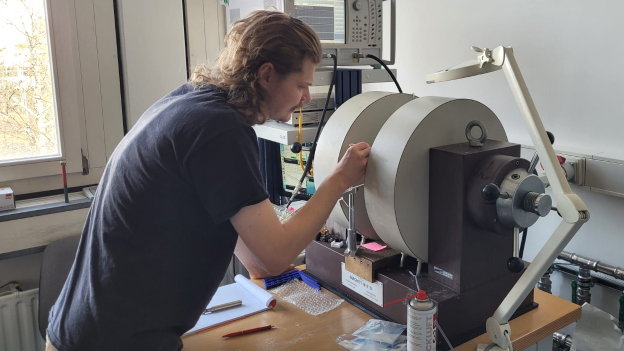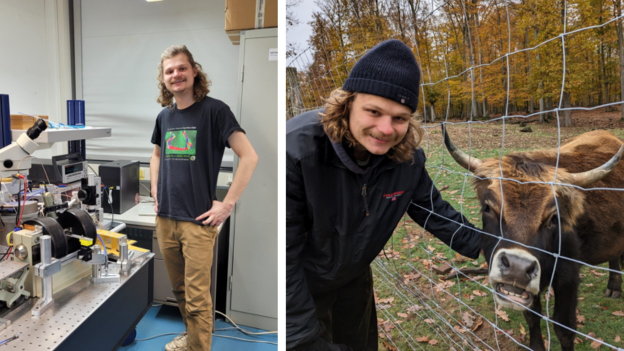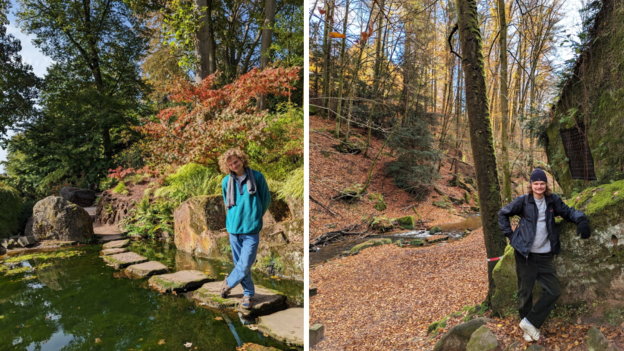William John Henderson
 Privat
Privat
Placing a sample in the magnet for testing
'I am incredibly grateful for the generous scholarship from the DAAD-Stiftung.
I was very pleased with the research that I was able to carry out with the great facilities at RPTU, and really enjoyed my interactions with researchers there. I will always cherish my memories, both academic and personal, from my time in Kaiserslautern.'
Thanks to the generous UK Scholarship from the DAAD Stiftung, William Henderson spend six months at RPTU Kaiserslautern-Landau conducting innovative experimental research in the field of spin waves.
He provides an insight into his work on new calculation and storage methods for computers and talks about his experiences with German music, German food and the German forest:
I am(/was) currently studying for a PhD in Condensed Matter Physics at the University of Oxford in the United Kingdom. I visited the University of Kaiserslautern-Landau (RPTU) for sixth months from September 2023 to March 2024 to carry out experimental research. The aim of this research is to understand how spin waves can effectively be used as a novel information carrier for computation. In the future, this could lead to faster and more energy efficient computers.
A computation is fundamentally a physical transformation of information. Due to the success of the continued development of the CMOS transistor, this information is typically represented by voltages. However, this information could instead be represented by any physical quantity. A spin wave – propagating disturbances of the magnetic spin system of a solid body – is a physical phenomenon with a number of potentially useful physical quantities (amplitude, frequency and phase) for representing and manipulating information.
The information transformations used in modern computing are those of Boolean algebra – that is, operations on zeros and ones. Associated with this scheme is the necessary memory management, where stored data must be physically transferred to the processor for processing. This arrangement is reaching its limitations, and so there is a need to develop novel methods of computation, and so novel hardware, which can avoid these.

Privat
A balance between science and relaxation
At RPTU, I studied non-linear interactions of spin waves. A consequence of non-linear interactions is that spin wave excitation at a single frequency will in turn lead to spin wave excitations at other frequencies. With researchers at RPTU, I developed an experimental setup to measure the different frequency components that were ultimately excited. The detection method involved an antenna in which the spin waves induced an electrical current. This electrical signal could then easily be measured using a spectrum analyser. Additionally, we used amplitude modulation techniques to consider the situation in which spin waves with multiple frequencies were initially excited. Amplitude modulation allows a complex frequency spectrum to be generated, without the requirement for an expensive GHz frequency arbitrary waveform generator, which is important for future commercial applications.
The results demonstrated a range of different secondary excitation behaviour, ranging from the excitation of discrete frequencies to the excitation of a broad continuous range – and some intermediate cases too. What struck me most about the results was how easy it was with the experimental setup to observe all these different behaviours. Whilst these have been observed before, measurements often involve optical techniques, which, since they involve not just electronics, are somewhat more technically difficult to implement.
This is promising for the future application of these phenomena in computational devices. In addition to these non-linear phenomena, I also observed a number of artifacts from the excitation process – for example, electromagnetic interference between the excitation and the detection antennae. These artefacts could present issues, however following discussions with other researchers at RPTU, I am now confident about their origin and how to mitigate their effects in the analysis process.

Privat
The captivating nature of Germany
Additionally, while working in Kaiserslautern I discussed aspects of simulations, and worked on integrating some of my code with their cloud-based simulation software, Aithericon. This was a great opportunity for me to learn more about the practical details of performing large scale simulations – something that is definitely going to be useful for the next steps of this research project. Now that I have returned to Oxford to finish my PhD, I am continuing to analyse this data, and writing simulations to conclusively determine the origins of the observed phenomena.
I hope that by successfully modelling my observations, my research can help lead to methods for controlling and manipulating spin wave interactions for computation. I remain in contact with my colleagues from Kaiserslautern and hope that I continue to do so. I enjoyed working at RPTU. There were a number of differences from working in Oxford. Firstly, the research group was much larger so a broader range of spin wave phenomena and applications were being studied, and more of the processes, for example fabrication of antennae, were done on site. Secondly, there was a wider range of equipment, so I became familiar with a range of new experimental techniques.
Life in Germany was surprisingly similar to the life in the UK in many ways. I often enjoyed a drink after work with colleagues, and chatting in the office about physics and life in general. However, there were a number of German activities I was not so used to. I visited the annual Quirnbach horse market, which was a very cultural experience, with a band playing German music and lots of German beer! I also enjoyed the German food, in particular the huge number of bakeries around the town with fantastic cakes!
I enjoyed visiting the wildpark in the forest adjacent to the city – walking through the forest and stumbling across a large area of land filled with a range of different animals. I spent many afternoons here. It was particularly pretty when it snowed, which happens rather rarely in Oxford. In Trippstadt, a short bus journey away, there was a really nice walk through the forest which I did when my girlfriend came to visit. I took part in the annual group retreat, and for the student day we hiked to a castle. In summer I visited the outdoor pool – one of the largest in Europe, and in winter I travelled to the nearby town of Landstuhl to go to the sauna.
As of April 2024.


